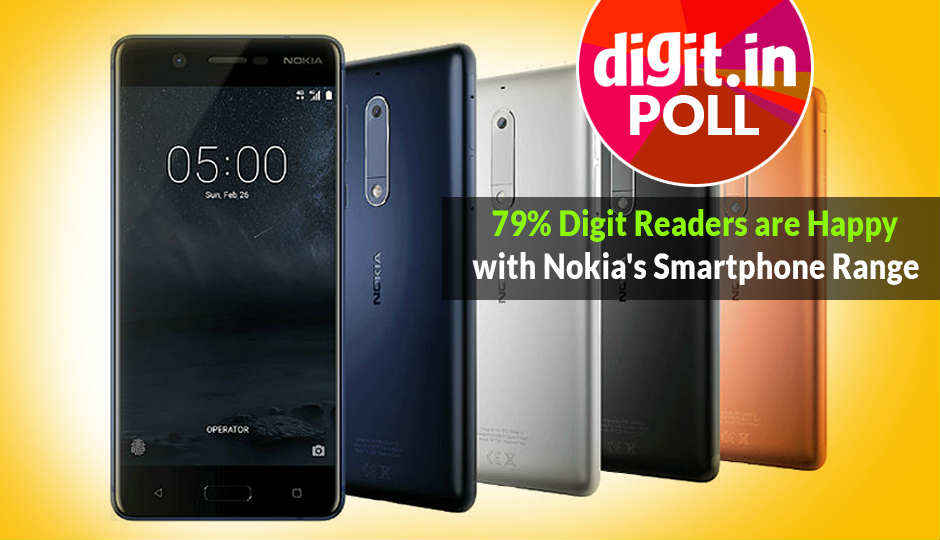Despite Nokia’s hallowed brand legacy there’s still work to do, Digit poll shows
Digit Poll show Nokia's brand image remains untainted, but the company still has work to do if they want to take on Chinese incumbents like Xiaomi, Motorola, etc.

No other brand is perhaps more hallowed among smartphone enthusiasts than Nokia. The Finnish company has nurtured and pioneered the mobile phone leaving an iconic legacy.
 Survey
SurveyNokia was a brand GenX identified with the most. In fact, Nokia was the first phone they ever owned. But owing to a few wrong choices, Nokia failed to keep up with changing times and soon found itself outdated. That’s when HMD Global was formed to revive the Nokia of the yore, this time, with pure Android.
Nokia arrived early in 2017 at the Mobile World Congress in Barcelona. It soon found itself in uncharted territory as Chinese incumbents like Xiaomi, Oppo, Vivo and the likes were aggressively pushing down prices and ramping up hardware, which obviously worked in favour of the smartphone buyer.
So we asked our readers their thoughts on Nokia’s resurgence and its comeback smartphone line-up. The answers we received proved that a historic legacy is far more valuable than aggressive marketing.
Of the 500 Digit readers who responded, 79 per cent said they were happy with Nokia’s line-up of Android devices while 21 per cent weren’t so satisfied.
The response was overwhelmingly in favour of Nokia with readers hailing the line-up’s build quality and design. However, once we went through the comments on the poll, a different story started to surface.
While readers appreciated Nokia’s decision to adopt pure, vanilla Android promising timely updates and security, they weren’t so happy with the hardware specs and the premium price Nokia is currently charging customers in comparison to Xiaomi, Motorola, and others.
Jaipal Singh, Senior Market Analyst for IDC, threw some light as to why this is the case.
“The market has totally changed from the golden days when Nokia used to rule the mobile phone space. We are now in the era of Chinese smartphone makers. They are very aggressive when it comes to pricing and hardware. Take Xiaomi for example. If you compare their pricing and specifications, it is very difficult to match up to that level. It is going to be a bit tough for Nokia this time,” he said.
Nokia also has some supply chain constraints resulting in low shipment volumes, according to Singh, which is keeping the brand from competing head to head with other players.
“We have noted complaints from retailers and distributors about supply issues. Nokia is a big brand with a presence in over 100 countries globally. Maintaining demand across all the market is a difficult task and it will take some good three to four quarters to smoothen the supply issues,” Singh said, indicating it’s still early to give the verdict on Nokia’s resurgence.
Moreover, Nokia’s lineup of phones is currently skewed more towards the online exclusive market. Among the entire lineup of phones, only the Nokia 3 and the Nokia 5 are available offline with the new Nokia 2 launched in the offline segment. In the online space, price and hardware specs are the main factors customers take in when buying a phone, which is where devices like the Nokia 6 (review) perform poorly.
Additionally, the online exclusive market is mostly restricted to tier 1 cities where phone makers like Xiaomi, Motorola, Lenovo and Samsung have a good hold over brand consciousness, and customers are used to devices with high-end specs and low prices.
Nokia is popular no doubt, says Singh, but it will take some time for the resurging giant to build back its presence. “In tier 1 cities where most of the online exclusive Chinese players have good presence, it will be very difficult for Nokia to make a strong comeback,” Singh elaborated.
The story completely changes when you look at the feature phone market though, which still comprises more than 50 percent of the smartphone market in India.
According to Singh, “Nokia was a leader in the feature phone market for a very long time and they made a comeback on a similar note in the feature phone market. Nokia launched the Nokia 105 and Nokia 130 in the previous three quarters. It’s really working well for them. We have seen their shipment volumes growing quarter by quarter,” referring to IDC’s analysis of the feature phone market.
Yet, despite having a majorly positive image, whether Nokia has indeed made a comeback or not will take some more time to decide.
“When it comes to feature phones, Nokia has a strong presence offline, but in the smartphone segment, we are yet to see anything significant in both offline and online segments. They have not made a real comeback as of now, so we need to wait for some more quarters,” Singh said.
Whether Nokia is selling phones or not, it is clear that Nokia’s image in the public mind remains untainted, and in a market as competitive as the smartphone market in India, that could be Nokia’s biggest asset.